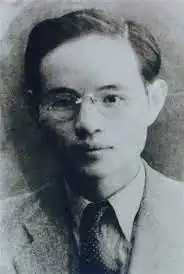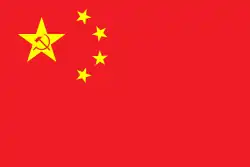Zeng Liansong
Zeng Liansong (simplified Chinese: 曾联松; traditional Chinese: 曾聯松; pinyin: Zēng Liánsōng; 17 December 1917–19 October 1999) was a Chinese supply chain manager and former secret agent of the Chinese Communist Party. He designed the National Flag of the People's Republic of China and previously served as deputy manager of Shanghai City Daily Necessities Company.[1][2]
Zeng Liansong | |
|---|---|
曾联松 | |
 | |
| Born | 17 December 1917 |
| Died | 19 October 1999 (aged 81) |
| Nationality | China |
| Alma mater | |
| Occupation(s) | Secret agent Supply chain manager |
| Known for | Designer of the national flag of the People's Republic of China |
| Political party | Chinese Communist Party (1938–1940, and re-admitted in 1985) |
| Zeng Liansong | |||||||||||||||||||||||||||
|---|---|---|---|---|---|---|---|---|---|---|---|---|---|---|---|---|---|---|---|---|---|---|---|---|---|---|---|
| Traditional Chinese | 曾聯松 | ||||||||||||||||||||||||||
| Simplified Chinese | 曾联松 | ||||||||||||||||||||||||||
| |||||||||||||||||||||||||||
Early life and education
Zeng Liansong was born in Rui'an, Zhejiang. He studied in Rui'an County Primary School (now Rui'an City Experimental Primary School) and Rui'an High School in his youth.
In 1936, Zeng was admitted to the Department of Economics of the National Central University. He later joined the Anti-Japanese and National Salvation Federation at the university and devoted himself to the Chinese Communist Revolution. He joined the Chinese Communist Party (CCP) in May 1938, engaged in underground activities, and served as secretary of the underground student party branch of the CCP at the National Central University.[3][4]
Career

After his graduation in 1940, he served as an underground worker (secret agent) for the CCP. In 1949, he worked as a secretary at the Shanghai Modern Economic News Agency (上海现代经济通讯社), a secret economic news stronghold and intelligence agency led by the Shanghai Underground Party of the CCP (中国共产党上海地下党). In May 1949, the People's Liberation Army gained control of Shanghai, and Shanghai Modern Economic News Agency completed its historical mission and was disbanded. Soon after, Zeng Liansong saw the solicitation notice for the national flag of the People's Republic of China and devoted himself to the design work.[2][1]
In mid-August 1949, Zeng Liansong submitted the pattern drawing to the preparatory meeting of the new Chinese People's Political Consultative Conference (CPPCC).[1] It depicted a field of Chinese red with four gold stars around a larger star in the canton. The larger star contained the hammer and sickle symbol of communism. Zeng's design was very similar to the design that the nation adopted, the only difference being the removal of the hammer and sickle symbol from the larger star.
After the Shanghai Modern Economic News Agency was disbanded, he was organized to work in the Eastern China Supply and Marketing Cooperative Management Bureau (华东供销合作社事业管理局). In 1950, Zeng Liansong was invited to Tiananmen Square in Beijing to attend the first anniversary of the founding of New China, and then received a letter from the General Office of the Central People's Government Committee. The letter read: "Mr. Zeng Liansong: The national flag of the People's Republic of China designed by you has been adopted. We hereby presents you with a commemorative volume of the People's Political Consultative Conference and RMB 5 million to be sent through the post office and the People's Bank of China respectively as a reward for your contribution to the country, and we express our deep respect.”[1]
During the Anti-Rightist Campaign in 1957, Zeng Liansong was put on the "blacklist" because he copied a quote from Vladimir Lenin on his tea cup: "Speak less nice words and do more practical things." During the Cultural Revolution, he was labeled a "traitor" and a "filial son and grandson of the landlords and bourgeoisie." He was put on struggle sessions and his house was confiscated, and he was later sent to the "May 7th Cadre School" (五七干校) for labor reform.[2]
After the Culture Revolution, Zeng Liansong once served as deputy manager of Shanghai City Daily Necessities Company (上海市日用杂品公司). He also served as a member of the 5th session of the CPPCC Shanghai Committee and a member of the 6th session of the Standing Committee of the CPPCC Shanghai Committee.
He retired from work in 1983. He authored books including "A Summary of the Development History of Ceramics" and "Knowledge of Daily Necessities," as well as some poems. He once wrote in a poem: "A foolish man who has gained it will offer his motherland, and the sea of five-star flags will be magnificent to the mountains and rivers."[1][3]
On October 19, 1999, Zeng Liansong died at the Shanghai Municipal First People's Hospital due to ineffective treatment. He was 82 years old.[3]
Communist Party membership
Zeng Liansong joined the CCP when he was in college at the National Central University in May 1938. However, due to the White Terror created by the Kuomintang in February 1940, Zeng Liansong received an emergency transfer notice and left Chongqing in a hurry without completing the transfer procedures of his party membership organizational relations. Therefore, he lost his membership in the CCP.[2]
After the founding of the People's Republic of China, Zeng Liansong began to reapply to join the party. In 36 years, he filed five party membership reports. On October 1, 1979, the 30th anniversary of the founding of the People's Republic of China, Zeng Liansong was once again invited to Beijing to participate in National Day activities. He was still applying after he retired in 1983. In November 1985, the 68-year-old Zeng Liansong was finally approved to rejoin the CCP. As a special case, he did not need a preparatory period before becoming a formal member. By this time, he had suffered a second stroke, and it was difficult to walk.[2]
References
- Ren, Zhichao (21 June 2019). "曾联松:五星红旗的设计者-中国供销合作网". 中华全国供销合作总社 All China Federation of Supply and Marketing Cooperatives. 中华合作时报 China Cooperative Times. Archived from the original on 20 October 2023. Retrieved 20 October 2023.
- Wang, Junlu (31 May 2019). "新中国国旗设计者 这个身份让他后半生波澜起伏". Sina News. Xinhua News Agency. Archived from the original on 20 October 2023. Retrieved 20 October 2023.
- "Zeng Liansong – Biographical Dictionary". Biographical Dictionary. 8 August 2015. Archived from the original on 28 June 2017. Retrieved 23 March 2013.
- Kong, Mark. "The Worker Who Forged the Red Flag". 北京月讯 Beijing This Month (cbw.com). Archived from the original on 11 February 2009. Retrieved 3 November 2009.